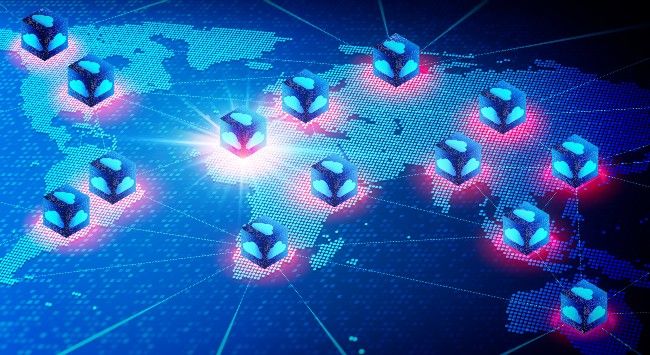Is the cloud giving you sticker shock? Many enterprises have started to realise that the cloud is not a fairy tale of winnings. The traditional cloud model has many drawbacks and limitations in today’s digital era.
The cloud’s full-time dependence on always-on high-speed Internet connectivity is problematic. There are also vendor-specific issues of scalability, reliability, and downtime. The issues related to cloud security have more or less found resolution. But some concerns persist, especially those related to privacy and location. Regulatory mandates restricting data transfer outside geographies inhibit cloud usage.
Edge computing solves most of these problems, though, and paves the way for rolling out next-gen apps.
Edge computing is a dispersed cloud processing model that brings computing resources close to the data source. The traditional cloud works with centralised infrastructure. The data gets transferred to distant servers, often across continents, for processing and storage. The edge uses concentrated servers and distributes processing infrastructure near the data. The data processing and storage at the network edge enable faster data processing and real-time analytics.
The issue of latency
Latency, or the lag when data transmit over long distances, is one of the major limitations of the cloud.
The conventional cloud model runs on limited mega data centres in remote locations. Data completes a round-trip from the device to these processing hubs and back in about 50-100 milliseconds over 4G networks. In 5G networks, the time reduces to less than five milliseconds. But even such high-speed transfers can cause lags for certain use cases.
New-gen apps, especially Artificial intelligence and Machine Learning powered ones, need instantaneous responses. The latency issue becomes more profound when the user is on the move or in a remote location. With more and more data generated and transmitted, data jams are becoming more commonplace. Even a slight delay can have serious implications that spell doom. For instance, even a millisecond of latency in the algorithms of a remote patient monitoring system could cost a patient’s life.
Edge computing overcomes latency by processing data close to the source. This enables
- Real-time data processing crucial for many time-sensitive applications
- Faster response time, improving performance.
One of the most promising use cases of edge computing is to unleash the power of Artificial Intelligence (AI) within apps. The rise of IoT devices and AI-powered data analytics has resulted in an extraordinary surge in data volumes connected to apps. The edge makes it viable to process and analyse such huge data loads. AI algorithms can execute in real-time without connectivity or bandwidth concerns.
Providing differentiated services
The edge offers businesses new data that unlock extra value. Businesses can harness such data to provide differentiated services.
For instance:
- Insurers get live telemetry data, enabling faster and more efficient claims processing.
- Utility providers can track real-time consumption and provide customised packages. The edge offers real-time insights and visualisation of energy consumption. Enterprises can drill down consumption to individual units or even user levels. Such insights could lead to new patterns of energy usage.
- Telecommunication operators can virtualise their Radio Access Networks (RAN). The edge enables RANs to perform complex functions with low latency. They reap cost, efficiency, and flexibility benefits. Edge computing overcomes the limitations and power network aerials to complement processing abilities.
Yet another use case is containers. The edge enables running off-the-shelf software containers fast, reliably, and efficiently. The possibility allows enterprises to build and scale micro clouds.
Bandwidth issues
Many remote and resource-constrained areas still have limited or no connectivity. In such situations, edge computing serves as mini data centres and resolves bottlenecks. Edge devices perform critical tasks at the local level, even without connectivity.
The edge also reduces bandwidth requirements. Edge nodes collect and process data from instrumented operational systems. It sends only the results to the centralised server. The bandwidth requirements and costs are reduced. Local data processing also reduces energy consumption and costs.
The edge makes viable technologies such as Augmented, Virtual, Mixed, and Extended Reality. Enterprises have not been able to leverage the potential of these technologies for many years now due to bandwidth issues.
Flexibility
Edge computing offers enterprises the flexibility and scalability to create seamless IT infrastructure.
The edge:
- Enables apps to break free of their data centre mothership. The edge puts processing horsepower wherever the user goes with the app.
- Improves scalability. The big three cloud providers. Amazon, AWS and Azure offer edge computing as well. Such public cloud edge computing offers an easy way to extend underlying cloud architecture and services.
Improved security
Local data processing improves data security and meets compliance requirements. Instant data processing at the edge:
- Identifies problems faster and enables nipping them in the bud. In high-stakes network security, even a millisecond delay in shutting down the network to thwart an attack can lead to ruin.
- Enable filtering and aggregating sensitive information before transmitting it to cloud servers. Such an approach minimises the exposure of raw data to external networks, reducing the attack surface and risk of a breach in transit.
- Allow enterprises to enforce better control over data sovereignty. They can meet mandates that restrict moving data outside specific jurisdictions. For instance, the European Union’s General Data Protection Regulations (GDPR) restrict the transfer of personal data outside the European Union to ensure the integrity of the protection levels imposed by the EU.
Use cases
The following time-sensitive apps gain through edge computing.
- IoT apps. Applications for smart home automation, industrial monitoring systems, and smart city infrastructure rely on real-time data processing to analyse and respond to sensor inputs. For instance, the edge processes sensor data in real-time to enable automated control of home appliances in a smart home. Likewise, processing data from traffic sensors enables real-time traffic management in a smart city.
- Online gaming apps. Gaming apps use the edge to sync game states and player interactions and ensure smooth gameplay. Currently, 97% of online gamers experience latency issues, and 34% of gamers quit the game or session if they experience any lag.
- Streaming apps such as Netflix and YouTube that deliver video and audio content to users in real time. These apps also use the edge to adjust the quality and resolution of the videos depending on the network conditions.
- Health and fitness apps that monitor and track users’ activities, such as step counts, heart rate, and calorie expenditure. Healthcare apps use the edge to send real-time notifications to patients and emergency requests to doctors and nurses.
- Robotics-enabling apps. The edge delivers alerts to enable customising actions of robots. The edge-powered apps leverage real-time data processing to control robot movements. Use cases include time-sensitive situations such as surgical procedures.
- Stock trading apps that display and execute trades based on live market data.
- Chat and messaging apps that deliver instant messaging functionality.
- Transportation and logistics apps that track vehicles monitor routes and offer live updates. This includes ride-sharing apps such as Uber and Lyft.
The global edge AI software market will grow from USD 590 million in 2020 to USD 1,835 million by 2026, with a CAGR of 20.8%. In the future, the cloud and edge will work in tandem. Apps will use Edge for real-time data collection and analysis and specific workloads. The conventional cloud will continue as centralised access points for large-scale analytic operations.













